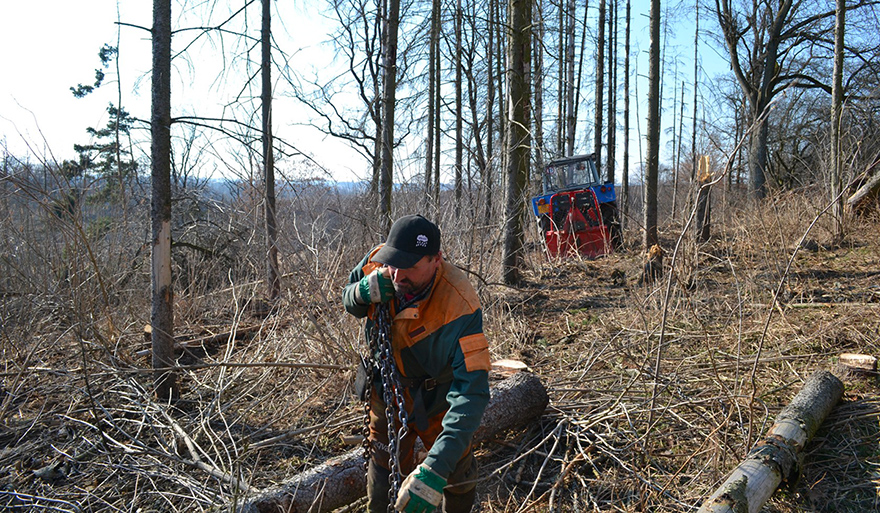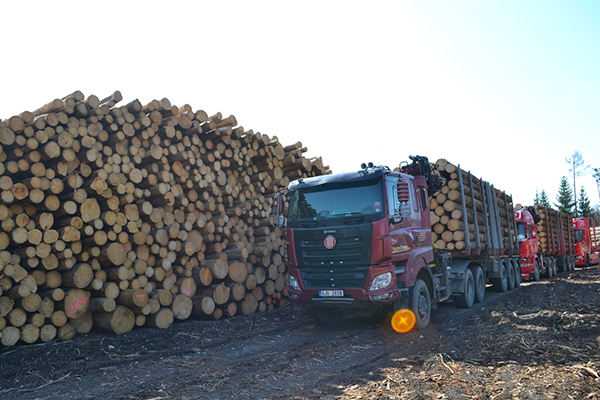Fighting a forest pandemic: hope sprouts again in the Czech woods
The bark-beetle epidemic has wiped out a large part of Czechia's forests in recent years, causing the collapse of the local forestry market. Now forest owners are planning a reforestation. The Czech National Restoration Plan, subsidised by the European Union, is intended to help them.

Telč (Czech Republic)
"Nobody could have imagined this madness," exclaims Zbyněk Baránek from the Borovná Forest Cooperative. We meet him on the outskirts of Telč, before heading to a place where just a few years ago there was a beautiful green forest. Today, viewed from a clearing, the forest consists only of stumps and a few remaining dead trees.
The cause of this is the bark beetle, whose depredations have been a disaster for Czech forests. Although the scourge is named after this insect, several other factors have enabled the bug's rampage. These include the planting of only spruce trees and the resulting monoculture; the ill-considered transformation of the economy after 1989; a failure of forest management in the central government; and, last but not least, climate change.
"I remember the year 2015, when there was an extreme drought," Baránek recalls. He thinks the alarm should have been sounded then. "Now you have dry feet where you wouldn't have walked in your boots a few years ago." We stop on a forest road that is empty of forest. In front of us are bare hills and the stumps of trees. A strong wind blows. Understandably: in a forest, trees stop the wind, but there are no trees here.

"I used to enjoy working in the forest even in the sweltering summer, because I could hide in the shade," says this experienced woodsman wistfully. "But now there’s no shade to be found." He shakes his head. The calamity has not only affected the forests he cares for, but also his very spirit. "I'll tell you about it at the place I go to find hope. Let's go!"
Nature will find a way
This man in his fifties has been working in forestry since he was eighteen. He has devoted his adult life to taking care of forests. Instinctively familiar with the terrain, he steers around potholes on his way to the "hopeful" place. Yet he admits that as the landscape has changed and the trees have disappeared, his sense of direction has deteriorated. "Sometimes I don't even know where I am. It's completely different here."
We pull over and head towards one of the hills. "So, here we are." He stops in the middle of the clearing. It's a little thinner than the others, but there is no great difference from other such places we have visited. Yet this is where he comes to recharge his batteries. He bends down and gently takes a tiny tree shoot in his hand. "They grow here too. Even here on this rock," he smiles. Indeed, the place is dotted with dozens of tiny trees. In a few decades, perhaps, they will dominate the hill.
"There were times when I thought, ‘I don't know if this work is still worthwhile’," he confesses. "But I look at the restoration now and I have hope again." For a long time, he also reflected on all the things he should have done differently, or better. But now he sees everything as if it was meant to be. He has also realised that nature needs to be listened to more. "We didn't admit it but the forests sensed their own fate. The trees were telling us."

Almost everything that could have been cut down has been cut down in the region. Now it is time to plant new forests. The “Building Climate-Resilient Forests” programme should help in this regard. This is a financial subsidy that forest owners can apply for. And Czechia’s National Recovery Plan, part of which will also go to forests, will receive funding from the EU’s Recovery and Resilience Facility.
This time, the aim is to plant in a way that makes forests more viable, more healthy and more sustainable. It sounds obvious that people should learn from the mistakes that led to today's calamity, but things are not so simple. In fact, the causes can be traced far back into the past.
A long fight
It is hard to pinpoint a single origin of the problem, and probably not even possible. Tomáš Vrška, a forestry expert from Mendel University in Brno, tells us that we could go back as far as the 18th century. "Back then, Hans Carl von Carlowitz wrote a book explaining how to use the forest productively," says Vrška. At that time, the land was full of nutrients and his method was a success. But forests today cannot be managed as they were then.
He also points out that the bark-beetle scourge is not the first time the forests have been in danger. As early as the mid-nineteenth century, spruce monocultures were already experiencing problems. Back then the trees were in poor condition, just as they are today, and the spruce beetle attacked them. "This time it is the third generation of spruce culture that is suffering," Vrška says.
And so, two centuries ago, today’s disaster was already in the making. Baránek recalls how this one started. "It came at us from the south-east." He describes the situation in warlike terms, and no wonder, because he was on the front line of those trying to stop the army of insects. He and his colleagues agreed that the only option was to cut down a thousand cubic metres of timber and quickly haul it away.
"We really did that. We cut it down and started exporting it," he confirms. He recalls picking up a piece of bark and seeing the writing on the wall. A tree is considered to be in a distressed condition if it has one beetle cavity per decimetre. But he found up to eight beetles per decimetre on each tree. "At that point I knew we didn't stand a chance."

For the foresters and other workers, the hard work then began. They worked from morning till night. At first, everyone tried to save the forest and to sell their wood at high prices, but the prices quickly fell. Later, everyone was just trying to sell the wood and didn't care how much. Even the Austrian sawmills stopped taking Czech timber. "The market in Europe collapsed," says Baránek.
Cheap timber, however, caught the eye of Chinese companies. "They took advantage of the fact that empty containers were coming back to China, and started putting wood in them," the forester says. The infested timber from the Czech highlands was loaded onto trucks, which took it away and loaded it onto wagons. Trains transported it to German ports and from there the wood headed by sea to China.
A new beginning, a new chance
Some timber is still being shipped to China, but the bitter fight against the bark beetle is mostly just a memory. Now the task of planting trees and reforesting has begun. It will be a long haul, like everything that happens in a forest.
"The first important step is to revive the soil," explains Vrška. The soil in the forests has lost its nutritional value due to monoculture and needs to be restored by pioneer tree species. These include birches, cranes, willows and poplars. A return to spruce-only forests is to be avoided.
The Forestry Act's detailed provisions, which differentiate tree species according to region, should help. In addition, EU subsidies will only be available to those who meet the conditions laid down. Vojtěch Bílý, spokesman for the Ministry of Agriculture, described the exacting administrative procedure to us. "Before carrying out the work, the applicant must submit a 'notification' in which he declares the scope of the work and the approximate extent of the grant sought in a given calendar year."

For some, the paperwork is just too much. "It´s a cliché of all subsidies," says Baránek. He helps people fill out forms and apply for money. "I've been doing this for a number of years and I always want to just give up after five pages," he sighs. Fortunately, he doesn't, and instead helps others build forests when otherwise many of them might have eschewed diversified planting. Vrška agrees that the main task is to change people's minds.
"If a forest owner is smart and responsible, then he chooses to plant forests for his grandchildren," explains Vrška. He emphasises the different perception of time when working with forests. And Zbyněk Baránek is proof that such owners exist. He may not be able to hide from the sun in his forests, but with luck his descendants will.
 This article was produced as part of the Union Is Strength competition, organised by Slate.fr with the financial support of the European Union. The article reflects the views of the author and the European Commission cannot be held responsible for its content or use.
This article was produced as part of the Union Is Strength competition, organised by Slate.fr with the financial support of the European Union. The article reflects the views of the author and the European Commission cannot be held responsible for its content or use.